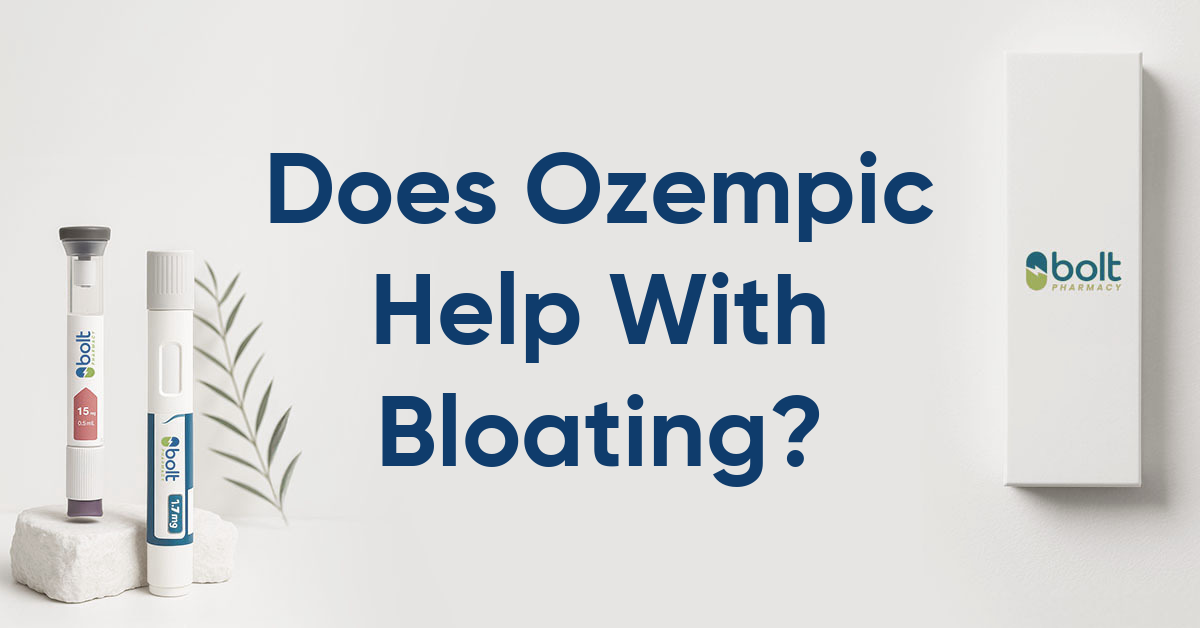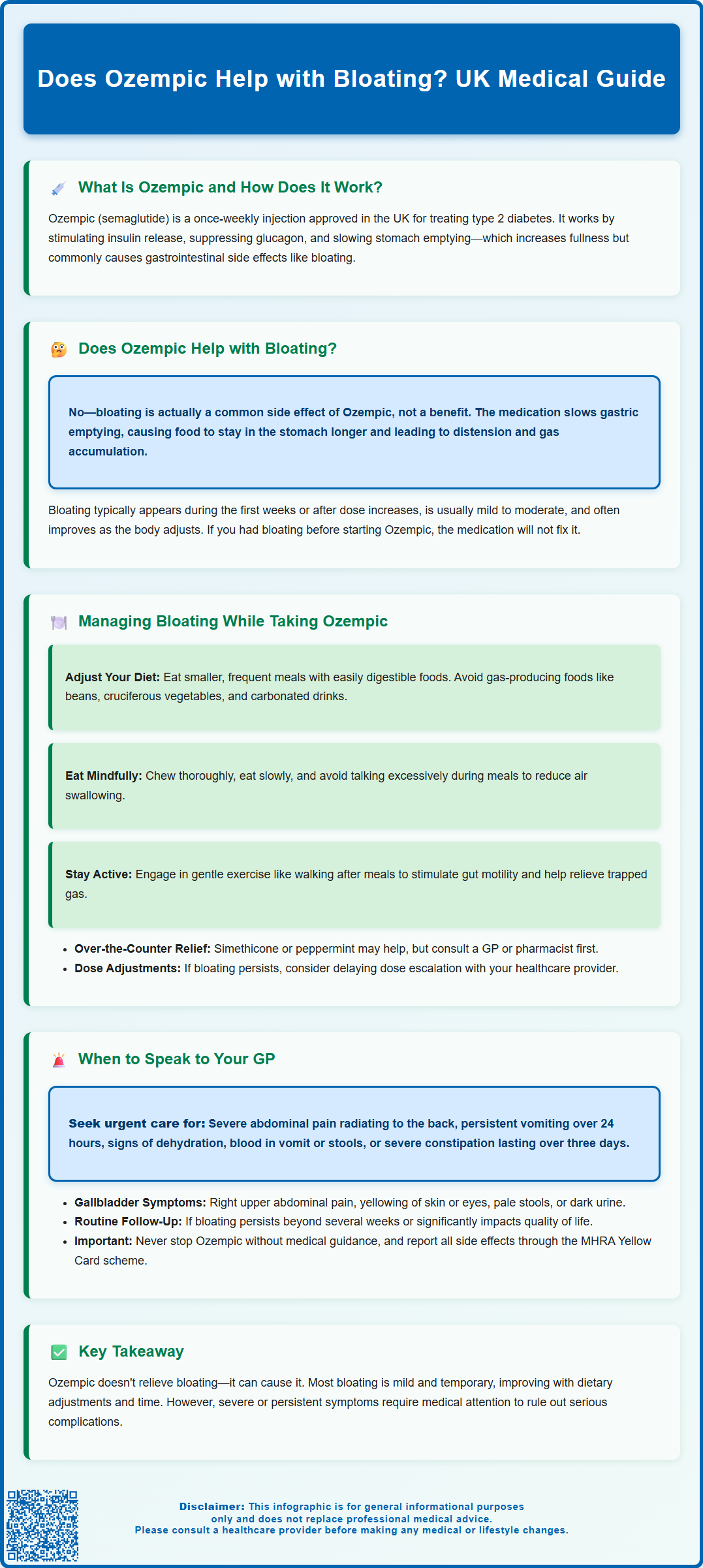Wegovy®
Similar to Ozempic, Wegovy also contains semaglutide but is licensed for weight management. It helps reduce hunger and supports meaningful, long-term fat loss.
- Supports clinically proven weight reduction
- Weekly injection, easy to use

Ozempic (semaglutide) is a GLP-1 receptor agonist licensed in the UK for treating type 2 diabetes mellitus. Whilst it effectively lowers blood glucose and promotes weight loss, many patients wonder: does Ozempic help with bloating? The evidence indicates that Ozempic does not relieve bloating—rather, bloating is a recognised common side effect of the medication. This occurs because semaglutide slows gastric emptying, causing food to remain in the stomach longer, which can lead to abdominal distension and discomfort. Understanding this relationship helps patients manage expectations and recognise when symptoms require medical attention.
Summary: Ozempic does not help with bloating; bloating is a recognised common side effect of the medication caused by delayed gastric emptying.
Ozempic (semaglutide) is a prescription medication licensed in the UK for the treatment of type 2 diabetes mellitus. It belongs to a class of drugs called glucagon-like peptide-1 (GLP-1) receptor agonists, which work by mimicking the action of a naturally occurring hormone in the body.
The mechanism of action involves several key processes. Semaglutide stimulates insulin secretion from the pancreas when blood glucose levels are elevated, helping to lower blood sugar. Simultaneously, it suppresses the release of glucagon, a hormone that raises blood glucose. Importantly, Ozempic also slows gastric emptying—the rate at which food moves from the stomach into the small intestine. This delayed emptying contributes to increased satiety and reduced appetite, which explains why weight loss is a common effect observed in clinical trials.
Ozempic is administered as a once-weekly subcutaneous injection, typically starting at a low dose (0.25 mg for 4 weeks), then increasing to 0.5 mg. After at least 4 weeks at this dose, it may be increased to 1 mg, and 2 mg only if additional glycaemic control is needed. This gradual titration helps minimise gastrointestinal side effects. The MHRA has approved semaglutide for glycaemic control in adults with type 2 diabetes, and NICE guidelines recommend GLP-1 receptor agonists as part of a comprehensive diabetes management strategy when other treatments have not achieved adequate control.
Whilst Ozempic has gained attention for its weight loss effects, it is essential to understand that in the UK, it is not licensed for weight management alone. A separate formulation called Wegovy (also semaglutide, but at higher doses) is specifically licensed for weight management in certain patient groups. The slowing of gastric emptying, whilst therapeutically beneficial for blood glucose control, is also responsible for many of the gastrointestinal symptoms patients experience, including bloating. These symptoms often lessen over time as the body adjusts to treatment.

There is no official evidence that Ozempic helps to relieve bloating—in fact, bloating is recognised as a common adverse effect of the medication rather than a therapeutic benefit. Clinical trial data and post-marketing surveillance consistently report gastrointestinal symptoms, including bloating, abdominal distension, nausea, and constipation, particularly during the initial weeks of treatment or following dose escalation.
The bloating associated with Ozempic is primarily attributed to its mechanism of slowing gastric emptying. When food remains in the stomach for longer periods, it can lead to feelings of fullness, distension, and discomfort. Additionally, altered gut motility may contribute to gas accumulation and abdominal bloating. Some patients also experience constipation, which can exacerbate bloating symptoms.
According to the UK product information, nausea and diarrhoea are very common side effects of Ozempic, while vomiting, constipation, abdominal pain, and abdominal distension (bloating) are common. These symptoms are usually mild to moderate in severity and typically transient, occurring mainly during the early weeks of treatment. The body often adjusts to the medication over several weeks, though individual experiences vary.
It is important to distinguish between expected side effects and symptoms requiring medical attention. Mild, transient bloating that gradually improves is generally considered a normal response to GLP-1 therapy. However, severe or worsening bloating, particularly if accompanied by persistent vomiting, severe abdominal pain (especially if radiating to the back, which may indicate pancreatitis), or inability to tolerate food or fluids, requires prompt medical evaluation. If pancreatitis is suspected, Ozempic should be discontinued immediately and urgent medical advice sought. Patients should never assume that Ozempic will alleviate pre-existing bloating conditions; if bloating was present before starting treatment, the underlying cause should be investigated separately.
Dietary modifications represent the first-line approach to managing bloating whilst taking Ozempic. Patients are advised to eat smaller, more frequent meals rather than large portions, as this reduces the burden on an already-slowed digestive system. Choosing foods that are easier to digest—such as lean proteins, cooked vegetables, and low-fibre options during the adjustment period—may help minimise symptoms. It is advisable to avoid foods known to cause gas and bloating, including beans, lentils, cruciferous vegetables (broccoli, cauliflower, cabbage), carbonated beverages, and high-fat meals, which further delay gastric emptying.
Eating slowly and chewing thoroughly can significantly reduce the amount of air swallowed during meals, which contributes to bloating. Patients should aim to eat in a relaxed environment and avoid talking excessively whilst eating. Maintaining good hydration throughout the day supports digestive function, though it may help to avoid large volumes of fluid with meals if this worsens distension.
Physical activity plays an important role in managing bloating. Gentle exercise such as walking after meals can stimulate gut motility and help relieve trapped gas. Regular physical activity, as recommended in NICE guidance for diabetes management, supports overall gastrointestinal health and may reduce the severity of bloating symptoms.
Some patients find relief with over-the-counter remedies such as simethicone (which helps break up gas bubbles) or peppermint preparations (though these should be used with caution in people with reflux symptoms). Evidence for their effectiveness varies, and patients should consult their GP or pharmacist before starting any new supplements or medications, as some may interact with diabetes treatments or mask symptoms of more serious conditions.
If bloating persists despite these measures, a dose adjustment may be appropriate. According to the product information, consider delaying dose escalation or reverting to a previously tolerated lower dose if gastrointestinal symptoms are troublesome. It's also important to monitor blood glucose more frequently if appetite or food intake is reduced, especially for patients also taking insulin or sulfonylureas, as there may be an increased risk of hypoglycaemia requiring dose adjustments of these medications.
Whilst mild bloating is a recognised side effect of Ozempic, certain symptoms warrant prompt medical attention. Patients should contact their GP, call NHS 111, or seek urgent care if they experience:
Severe or persistent abdominal pain, especially if radiating to the back (may indicate pancreatitis—stop Ozempic immediately and seek urgent medical attention)
Persistent vomiting or inability to keep down food or fluids for more than 24 hours
Signs of dehydration, including dark urine, dizziness, or reduced urination
Severe constipation lasting more than three days despite laxative use
Abdominal distension with fever, which may indicate infection or inflammation
Blood in vomit or stools, or black, tarry stools
Right upper abdominal pain, yellowing of skin/eyes, pale stools or dark urine (possible gallbladder disease, which is associated with GLP-1 receptor agonists)
Unexplained weight loss beyond what is expected with diabetes management
These symptoms may indicate serious complications such as pancreatitis, gallbladder disease, or severe dehydration that could affect kidney function. For severe symptoms or suspected gastrointestinal bleeding, go to A&E or call 999. NICE guidance emphasises the importance of monitoring for adverse effects during GLP-1 therapy, and healthcare professionals should be alert to symptoms suggesting more than typical side effects.
Routine follow-up is also important for patients experiencing persistent but less severe bloating. If symptoms continue beyond several weeks or significantly impact quality of life and dietary intake, a medication review may be warranted. Your GP can assess whether the benefits of Ozempic outweigh the side effects in your individual case and may consider:
Adjusting the dose or titration schedule
Investigating other potential causes of bloating (such as small intestinal bacterial overgrowth, coeliac disease, or irritable bowel syndrome)
Referring to a gastroenterologist if symptoms are atypical or severe
Considering alternative diabetes medications if Ozempic is not well-tolerated
Patient safety is paramount, and open communication with healthcare providers ensures that any concerning symptoms are appropriately evaluated whilst maintaining effective diabetes management. Never discontinue Ozempic without medical guidance, except if pancreatitis is suspected. If you experience any side effects, including bloating, you can report them via the MHRA Yellow Card scheme at yellowcard.mhra.gov.uk.
Ozempic causes bloating by slowing gastric emptying, which means food remains in the stomach for longer periods. This delayed emptying leads to feelings of fullness, abdominal distension, and gas accumulation, particularly during the initial weeks of treatment or following dose increases.
Bloating from Ozempic is typically transient and most common during the first few weeks of treatment or after dose escalation. Many patients find symptoms improve as the body adjusts to the medication over several weeks, though individual experiences vary.
Seek immediate medical attention if you experience severe abdominal pain (especially radiating to the back), persistent vomiting lasting over 24 hours, signs of dehydration, blood in vomit or stools, or fever with abdominal distension. These may indicate serious complications such as pancreatitis or gallbladder disease requiring urgent evaluation.
The health-related content published on this site is based on credible scientific sources and is periodically reviewed to ensure accuracy and relevance. Although we aim to reflect the most current medical knowledge, the material is meant for general education and awareness only.
The information on this site is not a substitute for professional medical advice. For any health concerns, please speak with a qualified medical professional. By using this information, you acknowledge responsibility for any decisions made and understand we are not liable for any consequences that may result.
Lorem ipsum dolor sit amet, consectetur adipiscing elit, sed do eiusmod tempor incididunt ut labore et dolore magna aliqua. Ut enim ad minim veniam, quis nostrud exercitation ullamco laboris nisi ut aliquip ex ea commodo consequat. Duis aute irure dolor in reprehenderit in voluptate velit esse cillum dolore eu fugiat nulla pariatur.
Block quote
Ordered list
Unordered list
Bold text
Emphasis
Superscript
Subscript